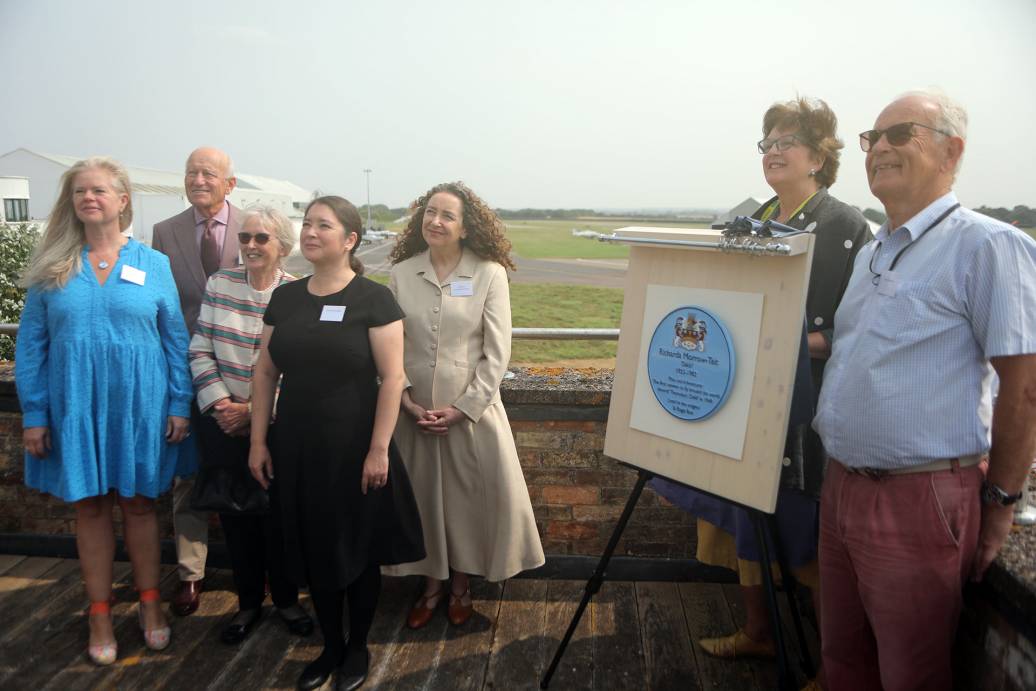
Richarda Morrow-Tait (1923-1982), a pilot and adventurer from Cambridge, has been recognised with a commemorative blue plaque marking her trailblazing achievements as the first woman to fly around the world.
An unveiling event for the plaque was held at Cambridge Airport on 19 August 2024, marking the 75th anniversary of the completion of Morrow-Tait’s flight. The plaque will be installed at Clare St Regis, Chesterton Road, Cambridge, on the site where Richarda once lived.
Richarda, known to friends and family as “Dikki,” was inspired to fly whilst at school during the 1930s, which was known as the golden age of female aviators. She was one of three people to sign up at Cambridge Aero Club on the first day possible after the wartime ban on civil aviation was lifted, and became the first person in the country to obtain a civil flying licence after the war.
Two years later, aged 24, Richarda left Cambridge Airport on 18 August 1948 to fly to her official start point of Croydon Airport. Her navigator was Michael Townsend, a mature Geography student from Fitzwilliam College, Cambridge, who had recently returned from war service with the RAF. The aeroplane was a Percival Proctor IV (G-AJMU). The flight was eventful and included a minor crash at the first stop in France; a nine-week delay in India for new parts; a forced landing in Japan by British Mustangs; an escort from a US B-17 to the Aleutian islands; and then a major crash in Alaska in snowy conditions.

Photograph: Richarda Morrow-Tait by PA Images
Richarda then spent four months fundraising for a new aeroplane including giving lectures, radio interviews, and singing in a nightclub. She also had to find a second navigator, as her first navigator had to return to Cambridge to sit his final exams and graduate from University. Richarda’s second aeroplane was a BT-13 Vultee Valiant (NX-54084). Her second navigator was Jack Ellis, who had also served in the RAF and who remained with Richarda for three months until her first navigator returned.
Richarda landed back at Croydon Airport on 19 August 1949 where she was greeted on arrival by her husband, her daughter and the press. Her flight had taken one year and one day.
At this pivotal time in Richarda’s life her home was in the St Regis flats, Chesterton Road, Cambridge. The flats have been replaced with student accommodation for Clare College, Cambridge, and the blue plaque for Richarda will be installed on the outside of that building.
“We are very pleased that the 40th plaque will be put up where Richarda lived before she set off on her amazing journey,” said James Littlewood, Chief Executive of local charity Cambridge Past, Present and Future, which runs the Cambridge and District Blue Plaque Scheme
“We hope her story will inspire passers-by and the students of Clare College, Cambridge.”
Marshall’s Group Director of External Relations and Communications, Christopher Walkinshaw, added, “We are proud to support the unveiling of this plaque to a remarkable woman who undertook an extraordinary and historic flight so soon after learning to fly at our Airport in Cambridge.”
Today, Richarda still holds the record for being the youngest woman with a navigator to fly around the world, and until 2022 retained the overall record for the youngest woman to fly around the world. She maintained her flying licence into the 1960s and lead a relatively quiet life after her round the world flight. She died aged 59, on 17 December 1982 in Maldon, Essex.
Group Captain Terry Holloway, a former Managing Director of the Kingdom Aero Club and the recently retired Marshall Historian, said “Dikki was a quite remarkable woman and a very competent pilot. In the early days of the Cambridge Aero Club in the 1940s she was remembered with huge fondness for her great enthusiasm and wonderful sense of humour as well as her great bravery in flying around the world.”